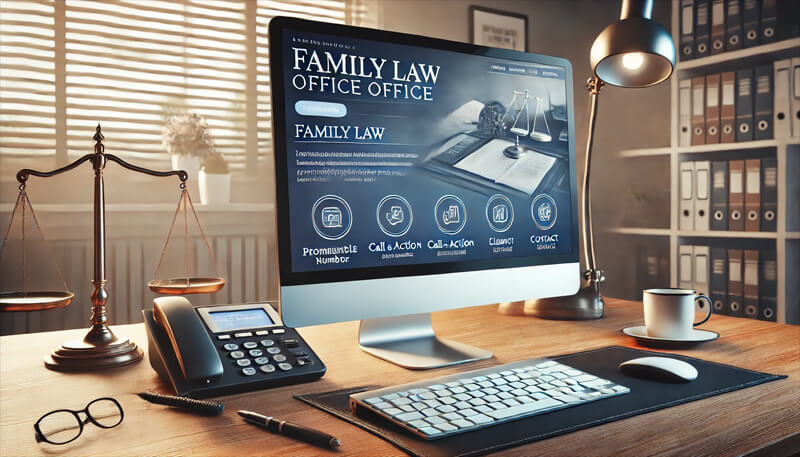Turn Your Family Law Website Into a Conversion Machine
Most family law websites are missing one thing: the basics. Take a look at your site right now—does it have a clear, prominent phone number? Can someone easily click it and call you, especially from their mobile phone? Believe it or not, this simple detail is missing on over 70% of family law websites. People searching for legal help aren’t looking to jump through hoops—they want to talk to someone now, and if they can’t find that contact information in seconds, they’ll move on.
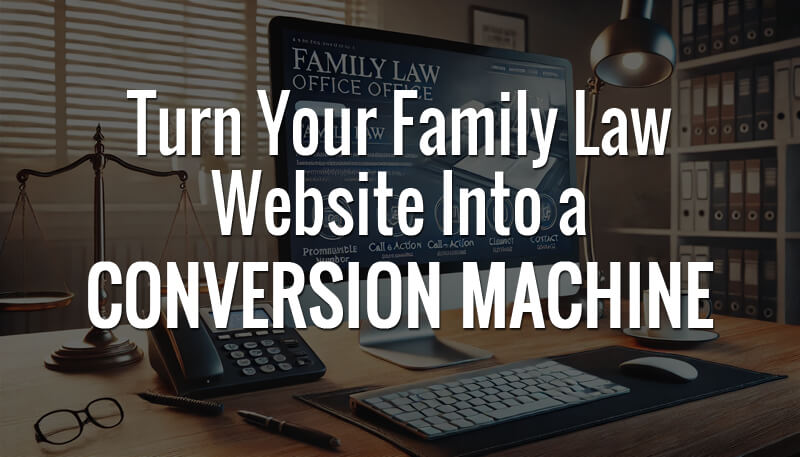
Getting the basics right is the first step to unlocking conversions. A clearly displayed, clickable phone number is often all it takes to turn a visitor into a client. If you can nail this, you’re already ahead of most of your competition. But that’s just the start. There are other simple, actionable strategies that can dramatically boost your site’s ability to convert visitors into paying clients. So, what’s next?
Keep reading, and we’ll cover exactly how you can turn your family law website into a client-conversion machine, from action-oriented calls to action (CTAs) to video testimonials that build trust. You’ll also learn why some old-school tactics, like newsletters and ebooks, just don’t work anymore. Let’s make sure your website isn’t one of those 70% that miss the mark.
Clear Calls to Action (CTAs) for Family Law Websites
CTAs are one of the most powerful tools to move visitors from browsing to actually picking up the phone. But here’s the problem: many family law websites either hide their CTAs or don’t make them strong enough.
A call to action (CTA) is a direct prompt to visitors to do something—usually to contact you. Whether it’s “Schedule a Consultation Now” or “Speak to a Divorce Lawyer Today,” your CTA needs to be crystal clear and easy to find.
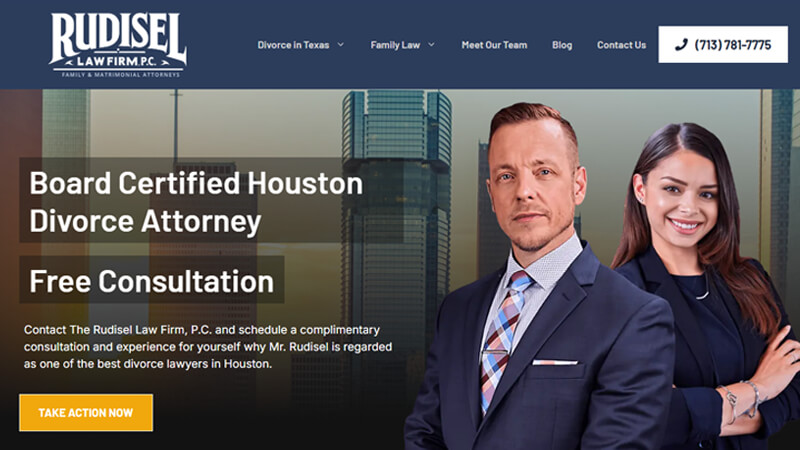
Where you put your CTA matters. It should be right where your visitors’ eyes go—front and center. The best spots? The header of your homepage, service pages, and even inside your blog posts. And make sure it’s above the fold—meaning it’s visible without scrolling.
Your CTAs should have urgency. Skip the vague “Learn More” or “Contact Us” and go for direct action: “Book Your Free Consultation” or “Call Now for Immediate Legal Help.” Action words like “Call,” “Talk,” and “Schedule” are your friends here.
Don’t underestimate design. Your CTA button needs to stand out—bright colors, bold fonts, and enough space around it to grab attention. It’s your conversion engine, so treat it like one. Visitors should see your button and know exactly what to do.
Not sure what to use? Try these:
- “Get Your Free Divorce Consultation”
- “Talk to a Family Law Attorney Today”
- “Start Your Child Custody Case Now”
If you can combine a CTA with a simple, clickable phone number, you’ve nailed it.
Optimized Contact Forms for Family Law Firms
After a solid CTA, the next step is making it easy for potential clients to reach you—this is where contact forms come in. But many law firm websites overload visitors with too many fields or make forms too hard to find.
Keep it simple. Don’t ask for too much up front—clients aren’t ready to give their life story yet. Stick with basics: name, phone number, email, and a brief description of their issue. Anything more, and you’ll scare them off.
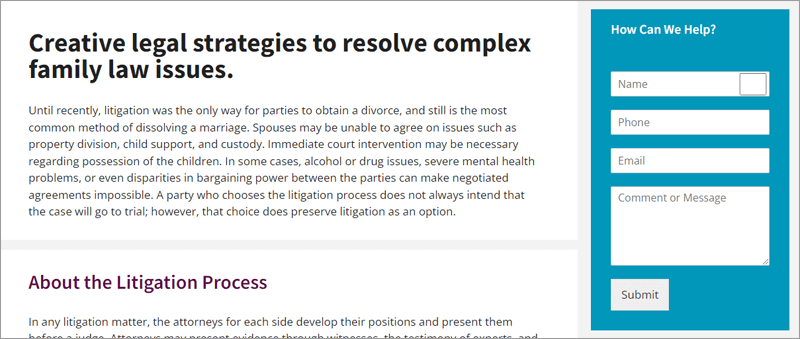
Here’s a simple, no-fuss contact form example:
- Full Name
- Phone Number
- Email Address
- Brief Description (optional)
- Preferred Consultation Time
That’s all you need to start the conversation.
Place your forms where they’re easy to find. The homepage, service pages, and sidebars are great spots. Don’t make visitors hunt around for them—they’ll give up before they find it.
When a client fills out a form, they expect to hear back fast. Set up an auto-responder that says something like, “Thanks for reaching out! We’ll contact you within 24 hours.” This builds trust right from the start.
A streamlined form makes it easy for clients to get in touch. The less effort required, the more likely they are to reach out, which means more leads for you.
Online Consultation Booking and Scheduling Tools
Clients want convenience. If they can book a consultation online, without back-and-forth phone calls, that’s a win for them—and you.
Let clients book consultations directly from your website. This is a massive time-saver and gives them control over the process, which can be comforting when they’re already stressed about legal issues.
There are plenty of tools like Calendly or Acuity that make booking appointments a breeze. These tools show real-time availability, so clients know exactly when they can get on your calendar.
Adding a booking tool to your website is easy. Most platforms integrate directly with popular website builders, so you can get up and running without hassle.
Seeing open slots in real-time encourages clients to book on the spot. This sense of urgency—knowing they can grab an available time right now—pushes them to take action faster.
Testimonials and Success Stories
When potential clients are deciding which family law firm to go with, social proof—like testimonials and case results—can tip the scales in your favor.
Potential clients want to know that your firm has helped people like them. Testimonials show that you’ve had success in cases similar to theirs. This builds trust and makes your firm look credible.

Video is even more powerful than text. Seeing and hearing from real clients about their positive experience is far more engaging than reading a paragraph of text. A video testimonial can help potential clients feel more connected to your firm, boosting their confidence in you.
Got a track record of success? Show it off. Display the results of past cases—without getting too deep into personal details—to give potential clients a sense of your firm’s abilities.
The more proof you have that your firm can deliver, the more likely visitors are to trust you with their case. Social proof is a powerful tool in converting leads into clients.
Make testimonials a focal point on your homepage or service pages. Visitors are often skeptical, so seeing testimonials immediately builds trust. Use them in prominent locations where they’ll have the most impact.
Using Videos to Boost Client Conversions
If you want to make a real connection with potential clients, there’s no better way than video. Why? Because a video of you showcasing your expertise and personality beats out any first impression your website text can make. People hire lawyers they trust, and nothing builds trust faster than seeing the person they’ll be working with. You can’t get that level of connection from a long list of credentials.
Videos let potential clients see you in action—how you speak, how confident you are, and how much you care about their case. It humanizes you and gives them a sense of what it would be like to work with you. That’s why video content is hands-down one of the most powerful conversion tools for family law websites.
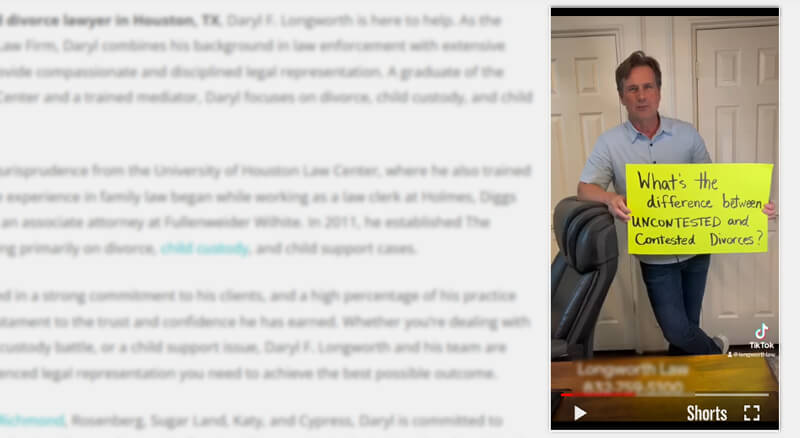
Video Testimonials for Lawyers
Hearing real clients talk about how your firm helped them through a tough time creates a personal connection. Video testimonials are far more powerful than written ones—they’re more authentic and more persuasive.
Family Law Case Results via Video
Use video to walk visitors through real case results (while protecting confidentiality). Explaining your successes in child custody or divorce cases can help potential clients see that you know what you’re doing.
Explainer Videos for Family Law Services
People are confused about the law—that’s why they’re looking for a lawyer. Short explainer videos breaking down complex topics like child custody or divorce proceedings build trust and keep visitors on your site longer.
“Meet the Attorney” Videos
Introduce yourself. “Meet the attorney” videos give visitors a personal feel for who you are, what your firm stands for, and why they should trust you with their case. This human touch is often what seals the deal.
Answering Questions in Blog Posts to Boost Conversions
Let’s be real: most law firm blogs are boring. They’re filled with tired, rehashed content that no one—not even search engines—finds useful. Generic blog posts don’t bring in clients. If your blog is just repeating what every other family law firm is saying, you’re wasting your time.
Instead, your blog should answer the real questions your clients are asking. You want to showcase your expertise, not just pad your website with filler content. Blog posts that tackle complex legal questions or offer practical advice get noticed. These posts not only help potential clients—they also boost your organic search rankings.

Want some blog post ideas that blow away your competition? Here are a few super-specific questions about family law in Texas that attorneys rarely think to address:
- “How do Texas courts handle child custody when one parent moves out of state?”
- “What rights do grandparents have in Texas child custody cases?”
- “Can you modify a child support order in Texas after the paying parent’s income increases?”
- “How does community property work in Texas for same-sex couples?”
- “What are the consequences of hidden assets during a divorce in Texas?”
These are the real questions people search for—and if your blog answers them, you’ll stand out from the crowd.
Outdated Methods That Are Hurting Your Conversions
You might have heard about the importance of newsletters, ebooks, and live chat from seminars or marketers. They make it sound like these tactics are a must-have for client conversion. But just because you’ve heard these strategies being recommended doesn’t mean they’re still working. Let’s break down why these methods are actually hurting your conversions today.
Newsletters and Ebooks
Let’s be real: people aren’t reading your newsletter. And if they are, they’re likely skimming it at best. Sure, marketers may tell you that building an email list is critical, but ask yourself—what’s in your newsletter that’s actually getting people to take action? And that ebook you spent hours creating? Most people probably never even downloaded it, let alone read it.
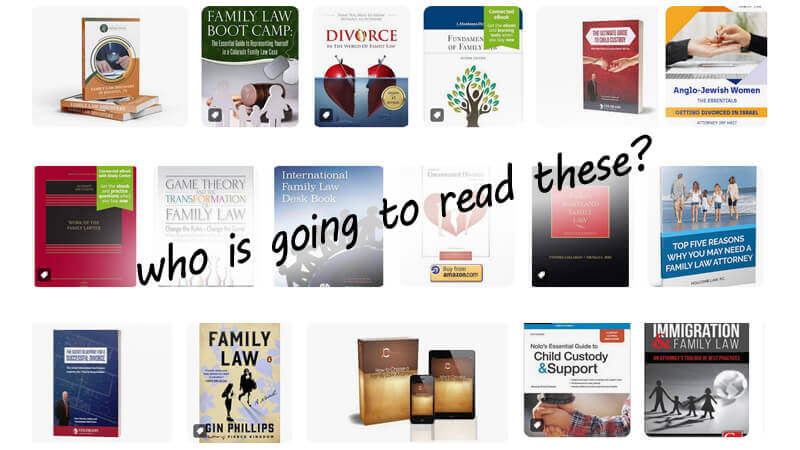
Here’s a stat that marketers might not mention: the average email open rate across industries is only about 21%. And in the legal industry, it’s even lower—closer to 17%. That means over 80% of your emails are likely going unread. And the truth is, most people don’t want another 10-page ebook cluttering their inbox either. They want quick, digestible information they can use now.
And let’s face it, your ebook probably doesn’t contain anything groundbreaking. Plus, you’re likely scrambling to find content for your newsletters each month, filling them with fluff that no one really cares about. So, instead of spending hours on these outdated tactics, it’s time to focus on strategies that actually work.
Live Chat
Live chat is another tool that sounds great when marketers pitch it, but here’s the problem: visitors don’t want to chat with a bot or a customer service rep—they want to speak directly with a lawyer. The instant they realize they’re not talking to you, the attorney, they’re likely to leave the chat and look elsewhere.
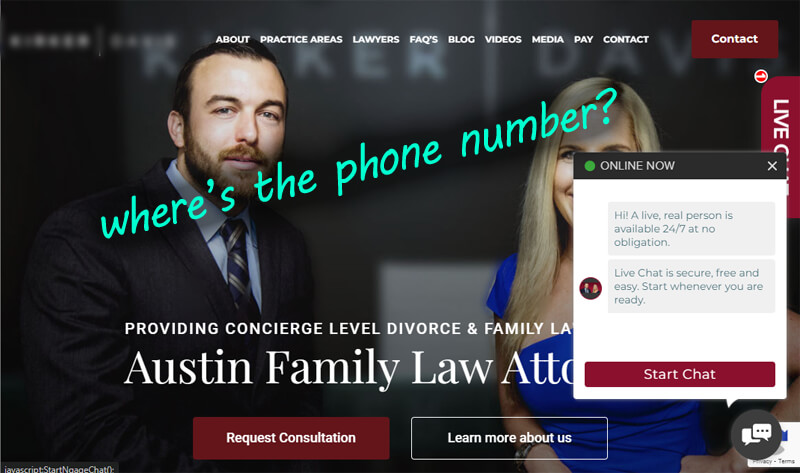
On top of that, live chat widgets can significantly slow down your website’s load time, which frustrates users and hurts your SEO. And what’s even worse? Live chat often overshadows the one thing that 99% of clients actually want—your phone number. A prominently displayed, clickable phone number is far more effective at converting visitors into clients than a chat widget that never delivers the personal interaction they’re hoping for.
Give Clients What They Really Want
Here’s the bottom line: visitors to your family law website want one thing—quick, direct access to legal help. A simple, clickable phone number and clear CTAs will get you most of the way there. Add in engaging videos and blog content that actually answers client questions, and you’ll be far ahead of the competition. Skip the outdated methods like ebooks, newsletters, and clunky live chat—they’re slowing down your conversions.
But you don’t have to tackle all of this alone.
Lucid Crew has been helping family law firms like yours convert more visitors into clients with cutting-edge web strategies that actually work. We know what makes clients pick up the phone, and we can help you make sure your website is doing the heavy lifting. If you’re ready to optimize your site and see real results, contact us today to schedule a consultation.
Let’s build a website that converts—because every visitor should be a potential client.
